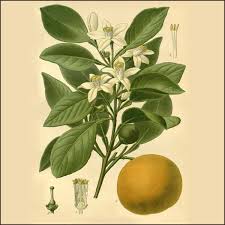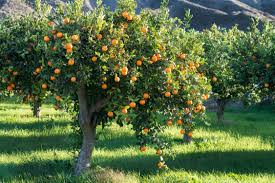Petitgrain essential oil is captured by steam distillation of the leaves and twigs of the bitter orange tree (Citrus aurantium var. amara or C. bigaradia), also known as the Seville orange. The blossom of the same tree yields the precious essential oil of neroli, with orange flower water being produced as a by-product of the distillation process.

There is also an essential oil from the rind of the fruit.
The bitter orange is an evergreen tree with glossy leaves. The white flowers are borne singly or in small clusters and are intensely fragrant. They are still in flower when the small, rough-skinned oranges appear. Although native to Southeast Asia, the tree is now cultivated extensively in the Mediterranean and sub-tropical regions throughout the world. Bitter Seville oranges are used commercially to produce candied peel and marmalade.
In former times the distilleries around Grasse produced an essential oil from the green, unripe oranges when they were still the size of a cherry, hence the French word petitgrains, meaning 'little grains'. Production of this oil proved to be uneconomic, for it greatly diminished the crop of mature oranges. So the traditional name was transferred to the oil extracted from the leaves and twigs.
To the connoisseur, the finest petitgrain oil comes from the south of France and other Mediterranean regions, although high-quality oils are also produced in Tunisia, Morocco, Egypt and Paraguay. The essential oil is a pale yellow or amber liquid with a fresh aroma that is reminiscent of orange blossom, although having a bitter, woody-herbaceous undertone. Its odour effect is generally perceived as cooling, relaxing and uplifting.

Various petitgrain oils are also produced from the leaves, twigs an small unripe fruit of other citrus trees, including the lemon, sweet orange, mandarin, clementine and bergamot - each oil having its own characteristic quality of aroma.
There is also a rare oil known as Petitgrain sur fleurs d'oranger, obtained by re-distillation of petitgrain essential oil over fresh orange flowers from the same tree (the bitter orange). However, this product - along with other unusual petitgrain oils - is obtainable only from specialist suppliers.
The Properties of Orange Leaves
Beyond the shores of the Mediterranean, orange leaves are rarely if ever used for medicinal purposes. Yet they have the same calming action on the nerves as the more commonly used orange flowers, and are therefore helpful for nervous tension, mild depression, palpitations, anxiety, insomnia and migraine of nervous origin.
If you live in a region where it is warm enough to grow your own orange tree, or if you have a conservatory spacious enough to house a smaller specimen, the leaves may be gathered for medicinal purposes. To make a nerve-calming infusion, put 4-6 fresh orange leaves in a teacup, then add boiling water and leave to infuse for 15 minutes. The usual dosage is 2 or 3 teacupfuls of the infusion daily - one to be taken at bedtime.
Aromatherapy and Petitgrain
Petitgrain oil, unlike most other essential oils, cannot boast a long history of medicinal use. Until fairly recently, it was used solely as a perfumery material. But it is an interesting oil with similar properties to those of neroli, and therefore helpful for nervous tension, anxiety, palpitations, mild depression and other stress related states. It works best when used in the bath or as a massage oil, especially if combined with other relaxing oils. When blended with detoxifying oils such as juniper berry, grapefruit and fennel, it is effective as a massage oil for fluid retention associated with PMS.
In skin care, petitgrain's gentle antiseptic properties make it helpful for spotty skin - and also dandruff associated with greasy hair. Use it in facial steam treatments, deep cleansing masks and skin and hair tonics.